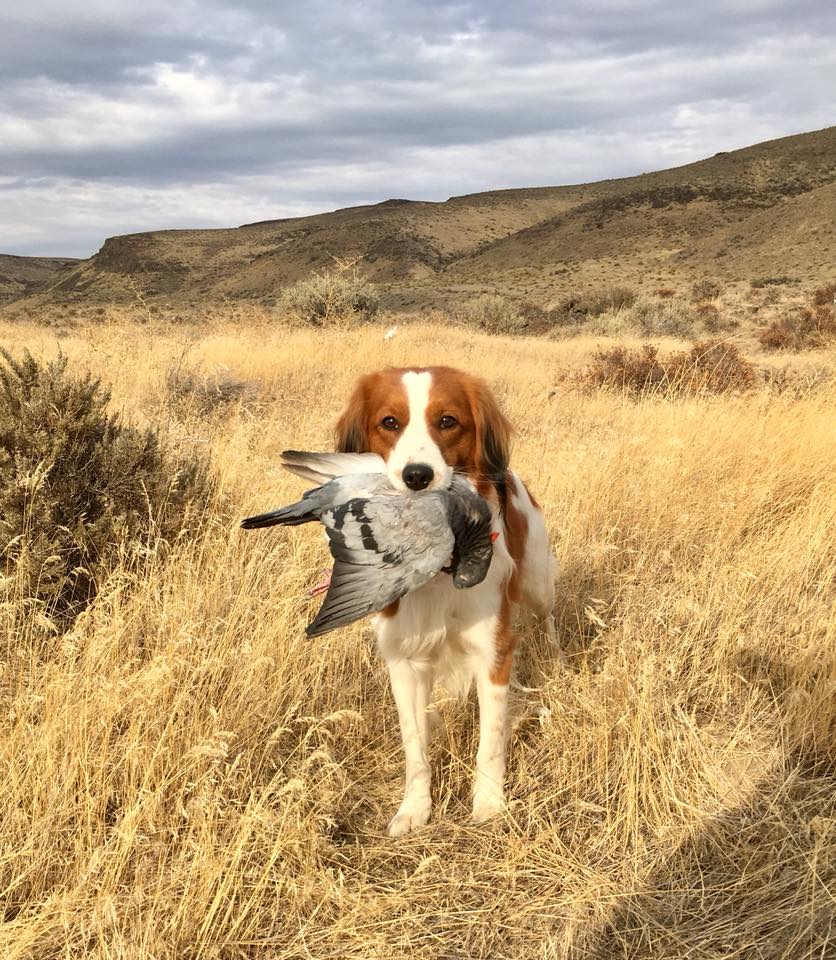
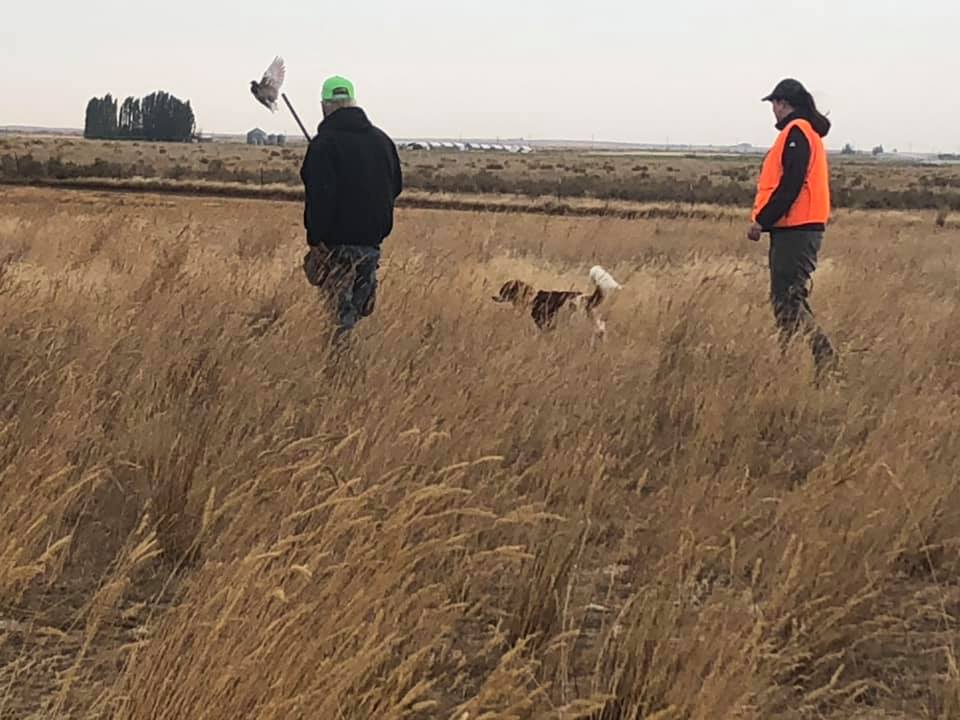
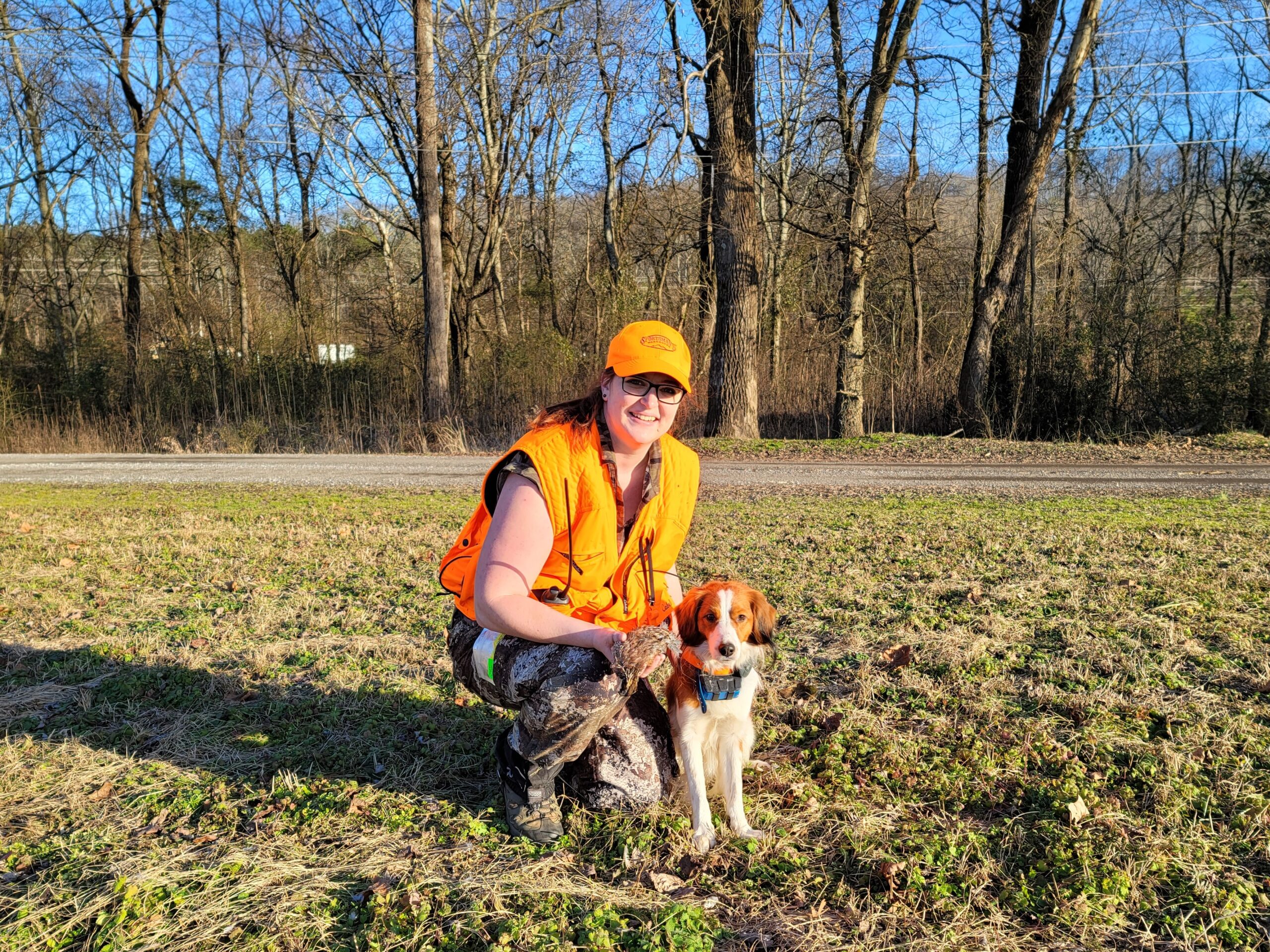
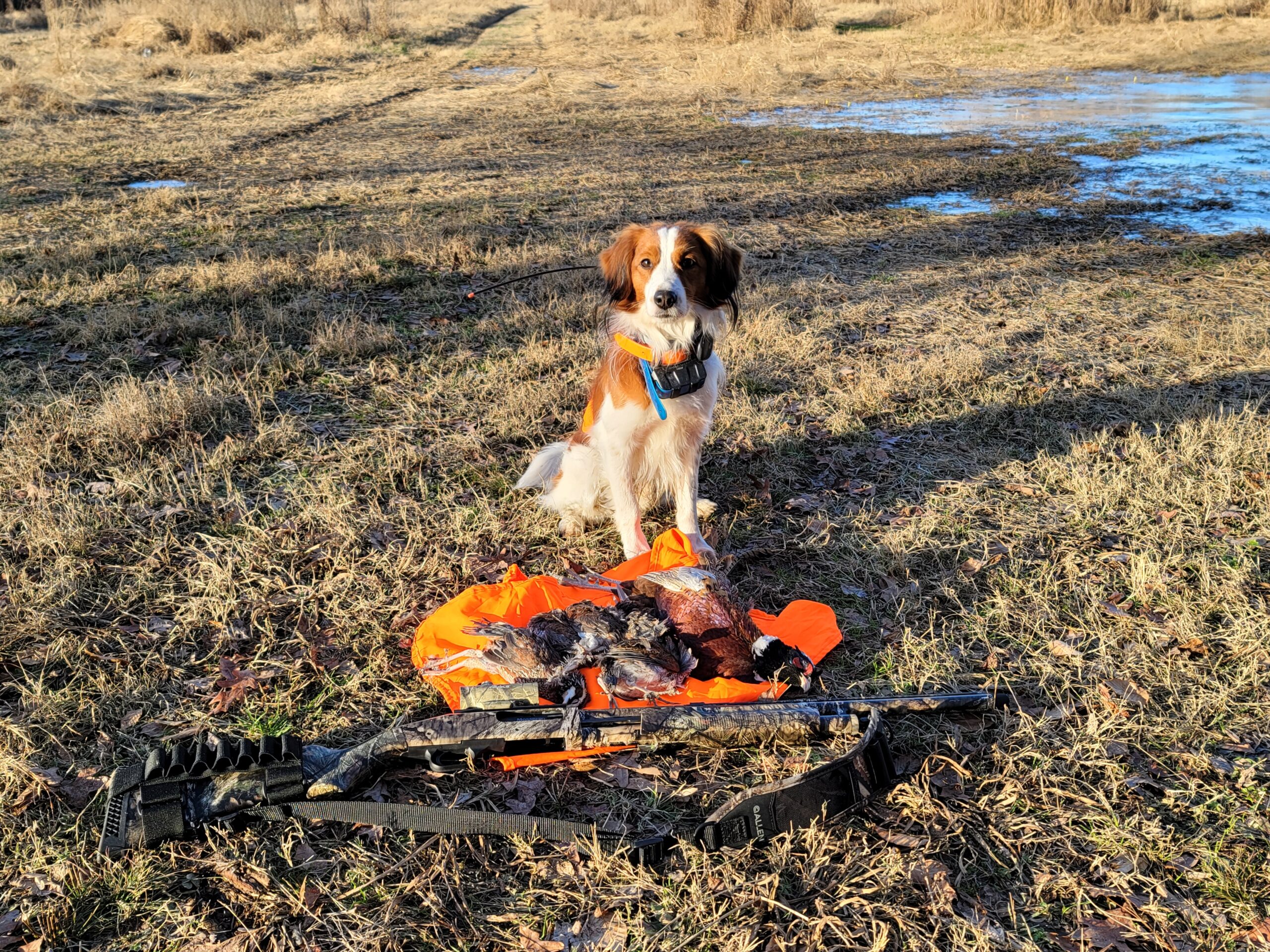
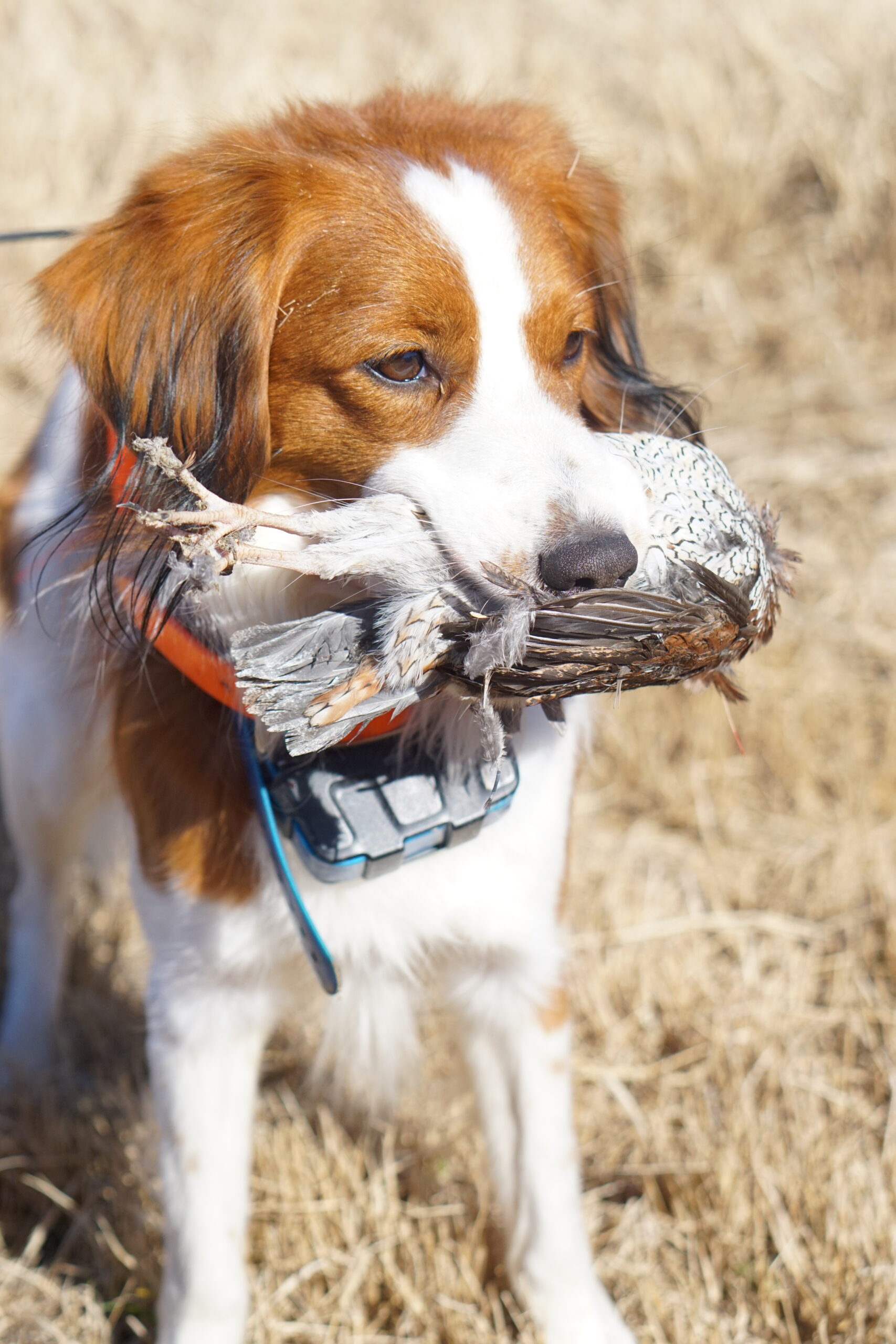

This Christmas weekend, Casper and I went out with a friend for a reserve hunt, where I was able to focus on shooting photos instead of birds so I could write this post! We had a great time, and it was northern-dog Casper’s first time on southern-bird bobwhite quail, so it took him a few finds to get the hang of it. But this fall, AKC added Kooikers to the list of breeds eligible to compete in spaniel hunt tests. As I’m the only American actively hunting with a Kooiker right now, I thought I should write this post about Kooikers as bird dogs… or gundogs. As it turns out, these words, commonly used interchangeably for most breeds, are not interchangeable for Kooikerhondjes, and this causes confusion about their work, abilities, and potential.
First, I’m writing this from an American upland hunting perspective, which means rough-shooting wild or released birds such as pheasants, quail, partridge, grouse, and chukar on private or public land – OR shooting planted birds at a private reserve. This is a different style of hunting than British-style driven shoots (I know of a few Kooikers that have worked those shoots with some success) or my Scandinavian friends who hunt the ginormous wild capercaillie (again where Kooikers have been used with some success). When I’m talking about hunting with Kooikers, I’m not talking about hunting waterfowl or turkey, or using them as hounds to hunt small game like raccoons and squirrels, nor coursing nor bloodtracking large game.
Nor, however, am I talking about this in the context of Kooikers’ original purpose – luring ducks into a catch area within an elaborate duck pond and canal trap system. This distinction is important to note – Kooikers are not, and have never been, gundogs. For this reason they were removed from their position within the British Kennel Club’s Gundog Group and reclassified into the Utility Group. In the US our equivalent is the Sporting Group, which doesn’t have such a strong implication of working under the gun, although the Kooiker is the only breed I’m aware of that is in that group and was not intended to work alongside an armed hunter. I use the term “gundog” to describe bird-hunting dogs like retrievers, setters, pointers and spaniels that are anything BUT Kooikerhondjes. But Kooikers, being bred to help a hunter catch ducks, can also be called bird dogs (as opposed to gundogs), and thus will show up in listings of bird dog breeds. Genetically, Kooikerhondjes are basal spaniels but that does not mean they have ever been bred for the birdy instinct that characterizes their more-derived relatives.

Gundogs
The work of a flushing spaniel/gundog is very dissimilar to any of the “jobs” that Kooikers were originally selected for, and breeders do not test or select dogs on their aptitudes for field work – simply because Kooikers are not meant to be flushing spaniels any more than a border collie or an American bulldog would be. I chose these breeds as examples here because I have seen both work successfully as gundogs, which is equally surprising as a Kooiker excelling at this work. But this illustrates: Kooikers (like these other breeds!) are not stupid dogs, and bird work, like any “dog job,” is a series of trainable steps – so it is accomplishable for a talented Kooiker and a dedicated trainer. It is a very different approach than one would take to train another breed of spaniel, or retriever, or pointer. The trainer must assume (correctly!) that any given individual Kooiker will have no innate instinct for bird work. I’m sure you have seen the videos on social media of 6-week-old pointers freezing and pointing at a bird wing on a fishing pole, or tiny retriever puppies working their hardest to retrieve a dummy or a bumper. Naïve young Kooikers simply don’t exhibit behaviors like this – and why would they? But this means that training a Kooiker is less about shaping and expanding existing instincts and talents – as it would be for most gundogs – as teaching each individual behavior from the ground up. While I personally find this training pleasantly challenging and rewarding, I have a high tolerance for failure: it won’t change my life significantly if my Kooiker does not turn out to be a good dog to hunt with – that’s not why I got Kooikers! However, for most hunters, a hunting dog is a valuable tool without which their lifestyle and hunting style cannot proceed, and that is why so many breeds of hunting dog have been developed so highly, with such strong instincts that training is minimized. Kooikers also don’t tend to respond well to harsh or negative training, and the vast majority of gundog training methods even today are based on traditional techniques that work well for other breeds, specifically force-fetch (conditioned retrieve) and the use of an electronic collar. And this is the danger of treating Kooikers like any other gundog – the training required to bring them to even a fraction of the proficiency of a young pointer or retriever is so significant that any serious hunter would burn out on the breed long before their dog is near field-ready. And this is why I think it is mildly dangerous to allow them in AKC spaniel tests and to create a market for less-than-scrupulous breeders to sell them as field dogs. While they can be in theory, it is only a tiny minority that may succeed with the right trainer, and serious hunters accustomed to more-traditional breeds are likely to find frustration with such a “soft” breed lacking the instinct and birdy drive common to all other gundogs.
Kooikers also have a number of physical limitations that make them less than ideal American gundogs. I personally do not hunt ducks or waterfowl with a Kooiker – recall the standard for females is 15″ and males 16″ at the shoulder, with an inch and a half leeway either side of ideal height. This is approximately the size of a cocker spaniel, but Kooikers have lighter frames even than cockers and weigh less, even with similar heights. Large water-logged mallards will weigh a significant percentage of a Kooiker’s body weight, and in rough and/or cold water and terrain, I think it’s unnecessarily risky to ask a small, slightly-built dog to do the work better accomplished by something like a Labrador. Notice a lab is at least twice the size of a Kooiker and of a different build more suited to the physicality of the work. While swimming and retrieving bumpers with Kooikers might be fun, I would not be comfortable duck hunting with the breed. Similarly, there are certain hunting situations and locations where hunters favor bigger dogs – many of my upland hunting peers in the inland West have serious concerns about snakebites, quills, and run-ins with wild predators. A taller dog runs less risk of death if bitten by a snake in the leg than the head or body, but a shorter dog is at a survival disadvantage in the same situation. Especially if one hunts wilderness far from transportation and veterinary care, one must consider not only the number of miles they expect a dog to hunt (shorter-legged Kooikers will tire after fewer miles hunted than a larger gundog) but also the ease of rescue in case of emergency.
Casper’s Hunting Style
That being said, I have a wonderful time personally training my Casper on birds. I began field training as a challenge for him around a year of age, after I noticed he was exceptionally drivey and biddable, and unlike every other Kooiker I’ve had or met, he did not display overwrought sound sensitivity. Kooikers were bred to work in silence, and many or most of them, even with extensive socialization, will remain too sensitive to sudden sounds to handle gunfire. We attended a grand total of two HRC training days and one weekend gundog-training camp, and the rest of his training I accomplished alone or with the help of friends. Slowly he became my public-land pheasant dog, and here in the South he has worked as a dove dog and now a quail flusher. I included his GPS track from this Saturday to illustrate his working style – you may recognize the telltale signs of quartering (zig-zagging back and forth within shotgun range of the handler) from this image. Casper works well within range with his nose low, and he is a better tracker than he is an air-scenter, which makes him deadly on running pheasants and less efficient with planted birds. He moves with the ground-covering fast trot that is seen in other gundogs, and his body language becomes visibly birdy as he catches and zeroes in on bird scent. As I don’t need it for my style of hunting, he is steady neither to shot nor wing. He marks extremely well – I can rely on him to find his birds without handling – and he will retrieve straight to hand. He is fearless on cripples and runners but has a soft mouth. All of these attributes and successes were trained behaviors – each was a piece we worked on and specifically trained, and none was instinctual except his reduced sound sensitivity as mentioned earlier.
This fall we started dove hunting and found that doves are so small and retrieves so short and simple that spaniels are perfect for this work. Casper personally was unaccustomed to still-hunting, and there is the added challenge that Kooikers were developed to be extremely visible to birds, so especially later in the season with wiser birds, he needed to be carefully camouflaged and taught to sit in a dog blind. But marking dove falls and making repeated retrieves from the blind, especially in a crowded public field, was a fun and easy exercise for Casper.
Kooikers are such a unique breed in their qualities and strengths that it’s often difficult for people used to existing patterns of behavior in groups of dogs to rectify the seemingly-contradictory information about them. Hunting is no exception – we see plenty of interest in them as hunting dogs but reputable breeders will either ignore these inquiries or take time to explain why they are not generally recommended as field dogs. This confusion is rooted in the fact that there is a difference between a bird dog and a gundog (and a genetic-spaniel and a flushing spaniel) where in all other breeds these words are assumed to mean the same. While I don’t wish to dissuade an eager trainer from attempting to train their Kooiker as a bird dog, as I certainly find it enjoyable myself, I want to make sure that the expectations of the abilities and limitations of the breed as a working gundog are well-understood. In that vein, I am happy to take anyone out hunting that may want to see a Kooiker in action if they are ever in the east Tennessee area during the season!